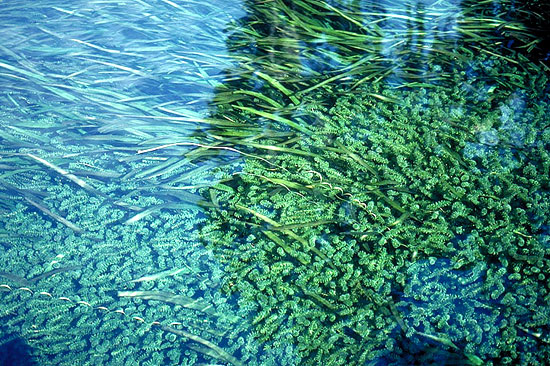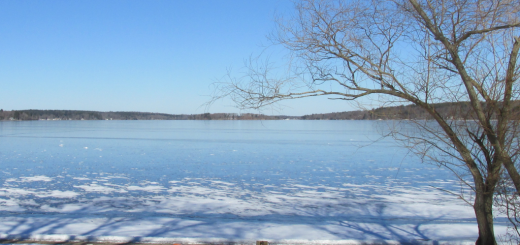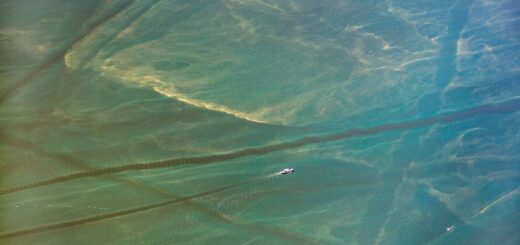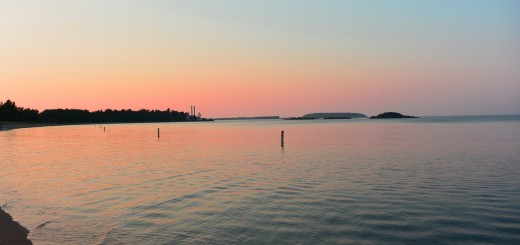Research Summary: Effects of Boating on Summer Nearshore Transparency at Lake Tahoe
0
Boats on Lake Tahoe. (Credit: Michael Alexander)
The geographic position of and physical setting surrounding Lake Tahoe combined with its exceptional size, depth, and transparency promises long standing prominence with residents and visitors alike. As the population in the Tahoe basin rapidly increased, the transparency of Lake Tahoe’s famed water declined. Unlike the winter clarity where there is a long-term trend of declining and then improving clarity, Lake Tahoe’s summer trend is a consistent long-term decline in clarity. Boating peaks during the summer, but since the average depth of Lake Tahoe is 1,000 feet and effects from boating turbulence are limited to depths less than 6 feet, one may not expect boating to degrade water clarity. However, the transparency of Lake Tahoe is so exceptional and the nearshore hydrodynamic impacts from boating so great, that while the shallow nearshore only comprises 2 percent of the surface area of the lake, this impact may be detrimental to Tahoe’s nearshore transparency. To evaluate this boating effects hypothesis, turbidity and transparency were measured in the nearshore during the summer of 2012 and compared to boating frequency and to Lake Tahoe’s 1 NTU nearshore numeric clarity objective.
Methods
The pier selected to investigate the nearshore is in water less than 6 feet deep and extends 230 feet north of water’s edge. The pier is located in the City of South Lake Tahoe, the largest urban region in the Tahoe basin. At this location and everywhere offshore on Lake Tahoe there are no restrictions on the size or number of boats and no limitations for boat operating depth. Turbidity is a measure of water cloudiness caused by suspended sediment and was measured in the middle of Lake Tahoe and at the pier most mornings and evenings between 1 June and 30 September 2012. The daily change in turbidity was calculated by subtracting the morning measurement from the evening. Transparency was also measured using a periscope to horizontally record the distance that a submerged 10-inch diameter black disc disappeared from view. Daily boat activity was estimated based on the Lake Tahoe Watercraft Inspection Program’s daily log of sealed vessel check-ins at the various launch ramps circling Lake Tahoe.

Secchi disk sampling near Lake Tahoe pier. (Credit: Michael Alexander)
Results
The average morning turbidity was 0.4 NTU and 0.8 NTU in the evening or an average change in transparency from 40 feet in the morning to 23 feet in the evening. Mid-lake turbidity averaged 0.3 NTU, or a transparency of approximately 56 feet. On average, there were 220 daily boat check-ins during the summer. Results were divided into days with above- and below-average boat check-ins, low intensity boating (less than 74 check-ins), and high intensity boating (greater than 355 check-ins). The average daily increase in turbidity following above-average boating was more than three times greater than following below-average boating. Furthermore, the average daily increase in turbidity following high intensity boating was 12 times greater than following low intensity boating, or an evening transparency of 33 feet following low intensity boating, but just 13 feet following high intensity boating. Finally, evenings following high intensity boating had a 50 percent probability of exceeding the 1 NTU nearshore numeric clarity objective while no evenings exceeded 1 NTU following low intensity boating.

Sediment rises after a boat passes over a section of nearshore Lake Tahoe. (Credit: Michael Alexander)
Conclusions
Wave action and turbulence from boating are likely to suspend sediment and release nutrients; both are causes of Lake Tahoe’s clarity loss. While a 5 mph speed limit is enforced within 600 feet of shore to minimize noise, there are no operating depth restrictions for boats in Lake Tahoe’s shallow nearshore. Just as the 1999 ban on two-stroke engines from Lake Tahoe greatly reduced the concentration of gasoline compounds in the lake at high boat use areas, reducing the hydrodynamic impacts of boating should reduce the summer nearshore suspension of sediment and nutrients, and this should improve the summer nearshore transparency at high boat use areas.
Full study and references published 2013 in Lake and Reservoir Management (29:4, 247-256).
Selected References
- Alexander MT, Wigart RC. 2013 Effect of motorized watercraft on summer nearshore turbidity at Lake Tahoe, California–Nevada, Lake and Reservoir Management, 29:4, 247-256
- Beachler MM, Hill DF. 2003. Stirring up trouble? Resuspension of bottom sediments by recreational watercraft. Lake Reserv Manage. 19(1):15-25.
- Goldman CR. 1988. Primary productivity, nutrients, and transparency during the early onset of eutrophication in ultra-oligotrophic Lake Tahoe, California-Nevada. Limnol. Oceanogr. 33:1321-1333.
- Lico, MS. 2004. Gasoline-related organics in Lake Tahoe before and after prohibition of carbureted two-stroke engines. Lake Reserv Manage. 20(2):164-174
- Schladow GS. 2012. Lake Tahoe State of the Lake Report. University California Davis Tahoe Environmental Research Center.













